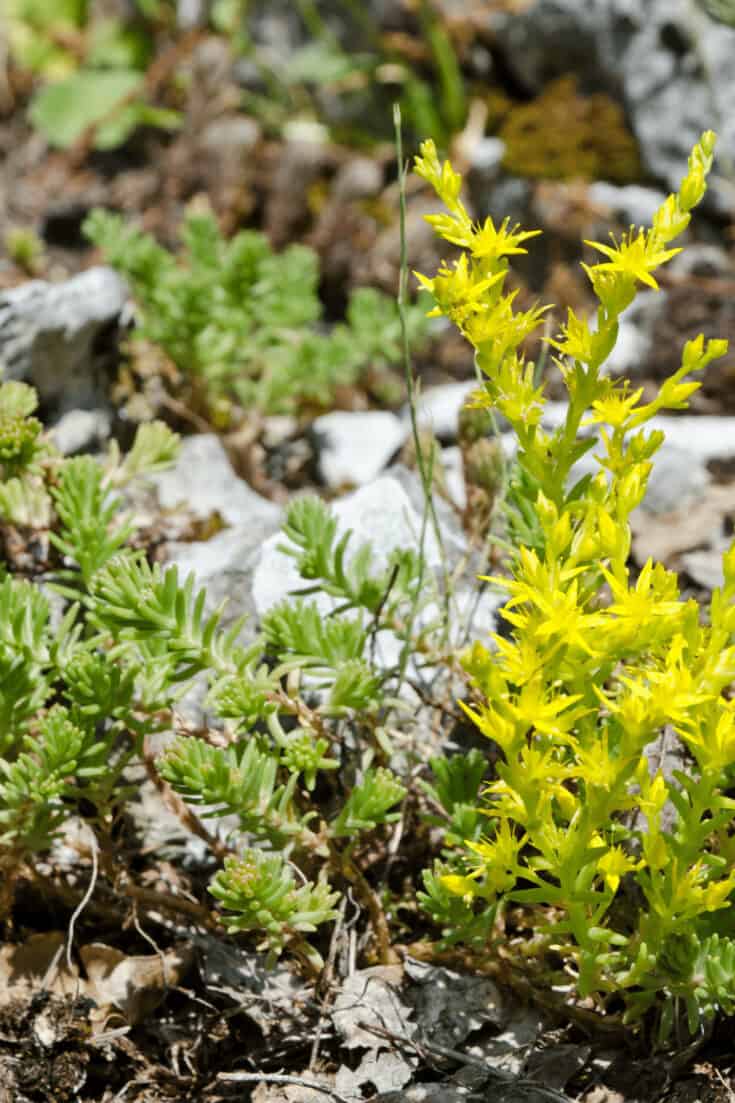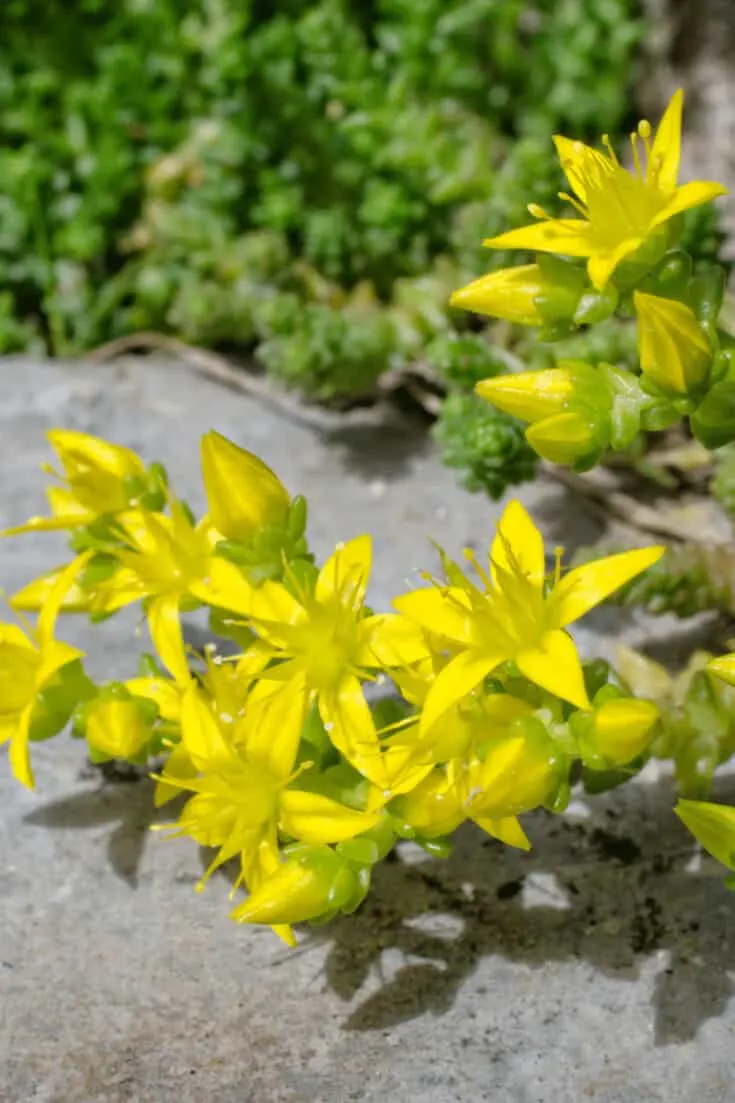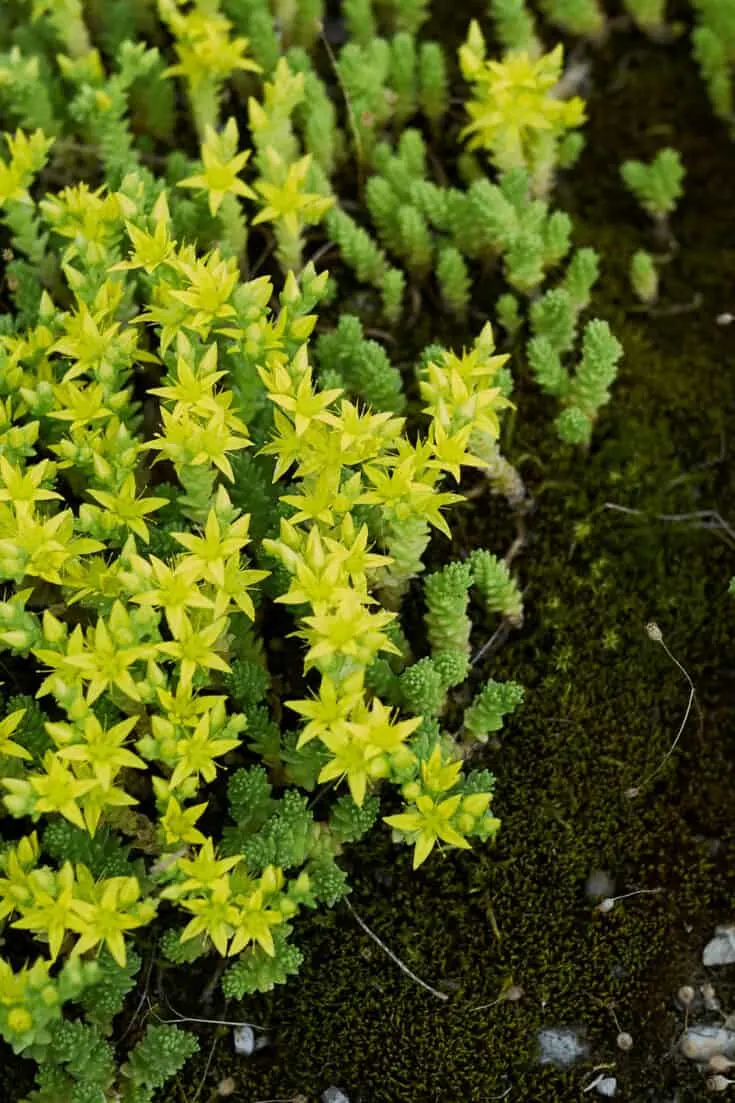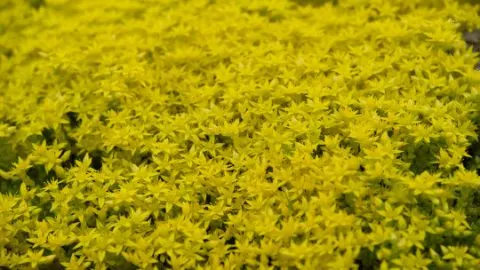I got my first Sedum acre plant by accident.
It was growing alongside another sedum I had purchased when I was just a beginner with succulents.
Within a few months, the 3-inch stem of Sedum acre was a palm-sized matted patch of golden mosslike growth.
Soon I had this hardy and drought tolerant creeper transplanted to a shallow wide clay tray of its own.
That’s how I started to grow Sedum acre, commonly known as mossy stonecrop, Goldmoss, biting stonecrop, or any combo of these words.
You get the gist, right?
The leaves are tiny and look like spikes. The “golden” in its name is from the flower heads, I daresay. In the flowering season, it is covered in bright yellow star-shaped blooms.
It’s found growing in Europe, North America, Japan, and New Zealand.
So, you can say Sedum acre is a species that’s better acclimatized to colder zones than many in its genus.
Sedum acre Care
To care for Sedum acre provide well-draining soil using a mix of limestone, gravel, brick chunks as well as river sand and some compost. Provide at least 6 hours of full sun. Water when the top 2” of soil is dry (5cm) and provide a temperature between 60-75°F (16-24°C). Fertilize once a month in sping and summer using an all-purpose fertilizer.

Sedum acre Care
Table of Contents
SEDUM ACRE CARE INSTRUCTIONS
Barely needs watering, not a sucker for humidity, No special temperature needs, no need to fuss over it in any way. Quite a hermit in the plant world. Let’s go through the details.
Soil
Sedums acre flourish in well-draining soil. If you give them a gritty combination of limestone, gravel, brick chunks along with river sand and some compost.
The soil needs to be really loose, non-compact, and quite non-organic.
Organic components like peat, mulch, compost, etc. should be less than 1/4th of the mix.
Your standard sticky garden soil or anything that’s somewhat clayey won’t work for this plant.
In fact, the soil you use to grow Sedum acre shouldn’t form a clump if you try to tightly compress a handful of it in your fist.
It is said the Sedum acre care requires slightly alkaline soil.
But in my experience, it grows in any pH level you give it as long as drainage is perfect.
If you have a rock garden at home, you should grow Sedum acre in that.
Having said all this, let me tell you that if there’s a clay patch that’s never watered and it is hard and dry, you may be surprised to see your Goldmoss creeping along the surface happily there!
But such miracles can’t be planned and clayey soil is certainly the wrong starter medium for Sedum acre care.
Light
Grow Sedum acre in full sun of at least 6 hours.
It will get an orange to reddish tint on the leaves.
You want to give it full unrestrained sunlight for a minimum of 6 hours a day.
Indoors is a total waste of space for this plant unless you give it very bright grow lights. Quite honestly, if you’re trying to grow a rock garden plant under grow lights, I would judge you!
My favorite spot for Sedum acre care is right on the roof where it gets unobstructed sun the whole day. That’s where it arrives in spring and stays there until mid-autumn before heading back to the east window by the kitchen for winters.
Pro-tip: Don’t place Sedum acre in direct sun as soon as you bring it from the nursery. This is a typical mistake that beginners make with sedums after reading all about them being sun-loving.
They need to be adapted to the full sun over 4 to 6 weeks after arriving home.
Watering
Water Sedum acre when the top 2” of soil are dry (5cm) and let it dry out in-between waterings.
The watering needs of Sedum acre care vary according to the stage of development and maturity.
During the propagation and early growth, it has very different requirements compared to a mature plant.
Here in this section, I will be addressing regular watering needs for a well-established plant.
Watering for propagation and juvenile plants is addressed in a separate section.
Sedum acre is a hardy succulent that stores moisture in its leaves and stems quite well. What it doesn’t tolerate is too much watering especially if the soil holds back any of that.
If you have been growing Sedum acre for about a year and it has spread to about a foot to two feet in diameter, then the “drench and dry” method works great.
You drench the soil whenever it goes bone dry during the growing season.
In winters you cut down drastically.
As long as the soil dries out very rapidly even if you water every 3rd day it’s fine.
Drainage is really the key here.
Very mature plants that have organically spread around rock gardens don’t need any watering at all!
Their living environment starts mimicking natural environments where they grow as they please drawing water from occasional rains and such.
Temperature
The ideal temperature for Sedum acre is 60-75°F (16-24°C).
You can grow Sedum acre outside in USDA zones 3-8.
The best thing about Gold Moss Sedum care is its temperature tolerance.
I’ve rarely come across plants with such a wide temperature tolerance range.
There are hot weather garden plants and there are cold weather garden plants. Sedum acre is present across the whole range!
It can survive in extreme conditions like great heat and even frost.
It can take up to -30°F (-34°C) i.e. it can survive under a blanket of snow! That’s why it makes such an amazing rock garden plant.
Some pro gardeners use these extreme temperatures to “stress” their Goldmoss into changing color. Goldmoss exposed to winter snow gets great hues when it sprouts back in spring.

Goldmoss grows best at a temperature between 60-75°F (16-24°C)
Fertilizers
Fertilize Sedum acre once a month using a liquid all-purpose fertilizer in the growing season in spring and summer.
You can grow Sedum acre quite successfully without any help from fertilizers.
However, if you want some action in the growing months you can give it good succulent fertilizers.
In early spring, I sprinkle crushed organic manure all over the soil where Sedum acre grows.
After that, I prefer giving it a flush of water-soluble all purpose fertilizer.
A once-a-month application during the growing season is more than enough i.e. 5 to 6 months in a year.
Look at the instructions of the packaging and dilute the recommended concentration to a fourth.
I would recommend that you fertilize it only if the plant is at least a year old or even two. You want the plant to be stable in its spot before you give it a growth spurt.
Propagation
Stem tip cuttings are the easiest way to propagate Sedum acre.
In my experience, it takes literally next to nothing to propagate them.
While propagating, this plant needs more consistent moisture and bright shade compared to other times. A peat-perlite mix or a peat-sand mix is a good medium for starting a plant.
You can use a sprinkling can and water from the top until the tips take root.
Once established, go back to low watering, high sun as detailed above. Transition gradually.

The easiest way to propagate Sedum acre are stem cuttings
Growth
There’s a reason Sedum acre is called Goldmoss. It grows like moss, low and tangled up and covering the ground. The average height is about 4 inches (10cm).
It spreads around pretty quickly too. Within the first year, with proper Sedum acre (which is borderline neglect) you can get a decent spread of over a foot in diameter.
Potting
The best of this plant can be exploited if you have a rock garden. If you don’t have one, don’t despair.
It grows equally well in wide containers but you need to be conscious of a few points here.
Plastic pots don’t work for Sedum acre in my experience. For ideal Sedum acre care their roots need to dry out pretty fast and plastic traps moisture.
Use anything earthen or terracotta so that the moisture can escape. The pot needs to have plenty of drainage holes, but you’ll face problems with the sandy soil running out of the pot through these holes.
The workaround is to use pieces of broken terracotta pots to make a shield around the drain holes before putting potting soil into it.
Another great container hack for Sedum acre care is to grow them on tiled window overhangs.
Because of their flowing growth habit, Sedum acre grown this way can look quite stunning.

Sedum acre only needs little water to thrive
STEP BY STEP GUIDE ON Sedum acre PROPAGATION
Sedum acre is prolific with respect to propagation.
You can easily grow new plants from fallen leaves, stem cuttings, and even seeds.
would recommend stem cuttings for home growers because of better chances of success.
Sedum acre propagation from stem cuttings:
- Choose a stem that is long to cut. Sometimes the stems have aerial roots. These are ideal. Cut a 2 to 3-inch piece along with the aerial roots if possible
- Allow the stem cuttings to callous for a day. Since Sedum acre has thin stems it callouses pretty quickly
- Stick the stems in the regular potting mix that has been moistened. Peat-perlite or peat-sand mix is ideally suited
- Water consistently keeping the soil slightly moist and keep the pot in bright shade
- Once roots are established in a few weeks, you can decrease watering and increase the sunlight gradually
- After about three months you can shift the plant to its a permanent place
Avoid propagating in the winter months. Sedum acre needs the warmth for rooting.
Sedum acre propagation with seeds
The seeds are very tiny and cumbersome to collect and propagate. However, professional nurserymen and botanists do collect seeds for propagation.
COMMON PROBLEMS WITH Sedum acre
Shrivelled leaves: This could happen if you grow Sedum acre with too little water.
This is an easy problem to fix as far as Sedum acre care is concerned. Just water the plant.
However, if the plant is very badly shriveled up, it’s a good idea to water in sips for a few days and then go to their recommended routine of “drench and dry”.
This way you can avoid an overwatering shock.
Stems dislodged from the base: This is a typical sign of root rot.
The soil mix is clearly too water retentive. Salvage the healthy stems for propagation and change the soil mix completely.
Stem rot or mildew: Topical watering without proper air circulation can lead to the crown of the plant rotting.
Avoid sprinklers and misting devices. Don’t crowd the plants or huddle with other plants. They need proper air circulation to stay dry.
Pest problems
Mealybugs: This hardy tropical is quite delightfully pest resistant. The only ever occasional problem I’ve seen is mealybugs.
They appear in fuzzy white spots under leaf nodes and quickly multiply until the plant is covered in them particularly at the tips where new leaves sprout. It’s an ungainly sight. It’s important that you don’t neglect the plant completely and keep an eye out for these sucking pests. Eliminate them at first sight.
TIPS TO KEEP Sedum acre PROBLEM FREE:
- Absolutely low watering. The moisture level should be droughty
- Soil needs to be absolutely well-draining and with minimum organic matter in them
- Gritty substances like gravel, sand, brick bits, perlite, pumice, etc. work well in the soil mix
- Excess moisture causes rots and diseases
- Well balanced dilute fertilizer works for them but only in the growing months
- The brighter the sunlight the better the leaf color
- Deadhead flowers to encourage fresh stem growth
- Established Goldmoss needs less care than juvenile ones
- Juvenile plants freshly purchased from the nursery must be gradually transitioned to full sun and low watering

Sedum acre will grow to a height of height is about 4 inches (10cm)
FREQUENTLY ASKED QUESTIONS ABOUT Sedum acre
Is Sedum acre invasive?
Sedum acre is fairly aggressive, spreading by seed and dropped leaves, so only plant where this isn’t an issue. They don’t choke other plants but they do get weedy popping up everywhere in a short while.
Can Sedum acre grow in shade?
These vigorous species will tolerate partial shade but they’ll lose their lovely hue. They won’t flower in shade either and they become quite dull and slow-growing over time. Also, the stems get leggy.
Is Sedum acre poisonous?
Sedum acre has low severity poisonous characteristics. The sap can irritate the skin of some people. It’s best grown away from traffic. However, birds seem to eat it and it doesn’t affect them.
CONCLUSION
In my experience, the best Sedum acre care hack is a slight bit of neglect – it grows best if you don’t fuss around it too much. Surprising but true!
You may be tempted to grow Sedum acre as an understory for big potted plants because they are low-growing mat-forming creepers.
Let me warn you that sedums are not suitable for that, as they affect soil salinity that may not be good for the big plant.
However, if you wish to grow Sedum acre in container gardens along with other succulents, that’s quite the popular thing to do in the succulent world.
You should try growing Donkey’s Tail sedum and some amazing cacti together.
Sedums are addictive. Luckily, as per the NCSU, there are over 300 species in the genus.
So, collecting and growing them can indeed become a sustainable hobby.
Happy growing!

Daniel has been a plant enthusiast for over 20 years. He owns hundreds of houseplants and prepares for the chili growing seasons yearly with great anticipation. His favorite plants are plant species in the Araceae family, such as Monstera, Philodendron, and Anthurium. He also loves gardening and is growing hot peppers, tomatoes, and many more vegetables.


